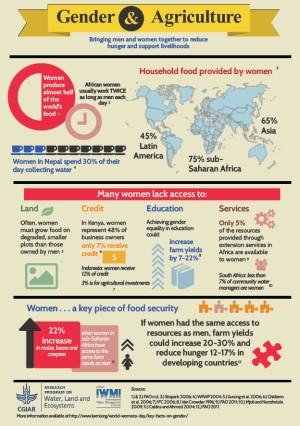
October 15 is the UN International Day of Rural Women. This day, which was first established in 2008 recognizes “the critical role and contribution of rural women, including indigenous women, in enhancing agricultural and rural development, improving food security and eradicating rural poverty.”
Gender inequity plays a special role within agriculture, as women are often pivotal to ensure household food security. Yet they are often not given access to resources or have little decision-making power. Improving equity therefore, means allowing the men and women affected by development to have a say in how resources are used. It also means helping decision makers to guarantee policies promote fair access to agriculture and natural resources. Gender, poverty, and institutions are therefore interlinked, and cannot be dealt with independently.
Citations for gender & agriculture infographic facts
1.) & 2.) FAO (Food and Agriculture Organization of the United Nations). n.d. Climate change, biofuels and land. Rome, Italy: FAO. Available at ftp://ftp.fao.org/nr/HLCinfo/Land-Infosheet-En.pdf (accessed on September 29, 2014).
3.) Stoparic, B. 2006. Climate change is a women’s issue. Women’s e-News, April 8. Available at http://www.alternet.org/story/38659 (accessed on September 29, 2014).
4.) WfWP (Women for Water Partnership). 2004. Role of women in management of water and sanitation: A case of Chadeni VDC. Available at http://www.womenforwater.org/docs/Nepal.pdf (accessed on September 29, 2014).
5.) Gurung, J.D.; Mwanundu, S.; Lubbock, A.; Hartl, M.; Firmian, I. 2006. Gender and desertification: Expanding roles for women to restore dryland areas. Rome, Italy: International Fund for Agricultural Development (IFAD). p. 5. Available at http://www.ifad.org/pub/gender/desert/gender_desert.pdf (accessed on September 29, 2014).
6.) Chidzero, A.; Ellis, K.; Kumar, A. 2006. Indicators of access to finance through household level surveys: Comparisons of data from six countries. Washington, DC: Brookings Institute and World Bank.
7.) IFC (International Finance Corporation). 2006. Access to credit for businesswomen in Indonesia. Washington, DC: IFC. Available at http://www.ifc.org/wps/wcm/connect/88095f0048855b358824da6a6515bb18/CreditAccessIndonesia.pdf?MOD=AJPERES&CACHEID=88095f0048855b358824da6a6515bb18 (accessed on September 29, 2014).
8.) Van Crowder, L. 1996. Enrolment of women in agricultural studies at intermediate and higher levels of education. Rome, Italy: Food and Agriculture Organization of the United Nations (FAO).
9.) FAO (Food and Agriculture Organization of the United Nations). 2011. Men and women in agriculture: Closing the gap. Rome, Italy: FAO. Available at http://www.fao.org/sofa/gender/key-facts/en/ (accessed on September 29, 2014).
10.) Mjoli, N.; Nenzhelele, R. 2009. Assessment of gender equity in water user associations. Water Research Commission. Available at http://www.wrc.org.za/Knowledge%20Hub%20Documents/Research%20Reports/KV-219-09.pdf (accessed on October 10, 2014).
11.) Caldes, N.; Ahmed, A.U. 2004. Food for education: A review of program impacts. Prepared for the Millennium Task Force on Hunger. Washington, DC: International Food Policy Research Institute (IFPRI).
12.) FAO (Food and Agriculture Organization of the United Nations). 2011. Women in agriculture: Closing the gender gap for development. The state of food and agriculture 2010-11. Rome, Italy: FAO. Available at http://www.fao.org/publications/sofa/2010-11/en/ (accessed on September 29, 2014).

